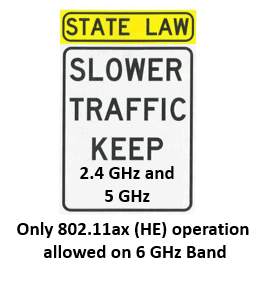国内有关WiFi 6E的资料较少,搬运一篇文章进来供参考学习,原文链接:https://www.litepoint.com/blog/wi-fi-6e-standard-and-channels/
LitePoint’s Eve Danel has developed this three-part blog series on Wi-Fi 6E and testing challenges. Throughout this series of blog posts, you’ll learn the basics of operating rules for Wi-Fi 6E in the 6 GHz band, the challenges when validating Wi-Fi 6E designs and what testing solutions LitePoint has available for Wi-Fi 6E.
Wi-Fi 6E Standard and Channels – 802.11ax Operation in the 6 GHz Band
In my previous blog post, I explored the FCC’s decision to open the 6 GHz band for Wi-Fi 6E standard operation, as well as the rules the FCC put in place to protect incumbent users in that space. Today I want to explore the IEEE 802.11ax rules of operation in the 6 GHz band and how they differ from operation in the 2.4 GHz and 5 GHz bands.
Background on Wi-Fi Standards

Two main groups are responsible for shaping Wi-Fi’s evolution. The IEEE 802.11 defines the technical specifications of the wireless LAN standard. The IEEE 802.11ax standard for high efficiency (or HE) covers MAC and PHY layer operation in the 2.4 GHz, 5 GHz and 6 GHz bands. It is scheduled to be finalized by the end of 2020.
The Wi-Fi Alliance focuses on certification of Wi-Fi devices for compliance and interoperability, as well as the marketing of Wi-Fi technology. To improve consumer understanding of the various IEEE 802.11 standard generations, the Wi-Fi Alliance decided to create consumer friendly names. The IEEE 802.11ax standard is now referred to as Wi-Fi 6 or the 6th generation of Wi-Fi and operates the 2.4 GHz and 5 GHz bands. Wi-Fi 6E operates in the 6 GHz frequency band. Thousands of devices have received Wi-Fi 6 certification since the program started and the Wi-Fi 6E certification is planned to start sometime in early 2021.
IEEE Rules of Operation
Decisions made by the IEEE 802.11ax group and added to the standard will make Wi-Fi 6E even more efficient.

Arguably one of the most important decisions made by the IEEE 802.11ax group is that it disallows older generation Wi-Fi devices in the 6 GHz band, which is important because it means that only high efficiency 802.11ax devices will be able to operate in this band.
Historically, newer Wi-Fi standards have always provided backward compatibility with older generations. This proved to be a great strength to win over consumers, since network equipment doesn’t need to be completely overhauled at each new generation. This has also been a source of congestion, since older slower legacy equipment is sharing available resources (i.e. spectrum) with newer devices. In the 6 GHz however, only new high efficiency devices will be allowed to operate.
When using the analogy of a freeway to describe Wi-Fi, the 2.4 GHz and 5 GHz band can be compared to congested freeways allowing both fast and slow vehicles, while the 6 GHz band is the equivalent of a new, large freeway that only allows the fastest cars.

With 1200 MHz of spectrum and 59 new 20 MHz channels, a station with a dwell time of 100 ms per channel would require almost 6 seconds to complete a passive scan of the entire band. The standard implements a new efficient process for clients to discover nearby access points (APs). In Wi-Fi 6E, a process called fast passive scanning is being used to focus on a reduced set of channels called preferred scanning channels (PSC). PSCs are a set of 15 20-MHz channels that are spaced every 80 MHz. The APs will set their primary channel to coincide with the PSC so that it can be easily discovered by a client, and clients will use passive scanning in order to just scan PSCs to look for an AP.

To further improve the efficiency of the 6 GHz operation, the standard is also segregating most of the management traffic to other bands. So, a multi-band AP that has 2.4 GHz and 5 GHz will be discoverable by scanning the lower bands. The client will first go into the lower bands, discover the AP there and then move to the 6 GHz band. This way, no probe request frames will need to be sent in the 6 GHz band. This will reduce the probe requests that are sent by stations just trying to find APs because it will not be allowed unless it is a PSC channel.
Wi-Fi 6E Channelization

The 802.11ax standard also defines channel allocations for the 6 GHz band. This allocation determines the center frequencies for 20 MHz, 40 MHz, 80 MHz and 160 MHz channels.
Channels begin at the start frequency of 5950 MHz, leaving just 25 MHz of guard band between the first 6 GHz channels and the upper range of the U-NII 4 band.
If a U-NII band is not allowed in a specific regulatory domain or operates under different rules, then the regulatory specs take precedence over IEEE and channels that are falling on frequencies or overlapping on frequencies that are not supported, are not allowed.
The FCC is providing this pristine new highway of spectrum and the Wi-Fi 6E standard’s rules of operation are ensuring that we can remove the slowest vehicles on the highway. The question now is how do you build the next generation, high performance device that can really take advantage of this new spectrum? There are many challenges to overcome.
In the next post, we’ll explore what testing solutions LitePoint has available for Wi-Fi 6E. In the meantime, please visit the replay of my webinar on this topic.






















 656
656











 被折叠的 条评论
为什么被折叠?
被折叠的 条评论
为什么被折叠?








